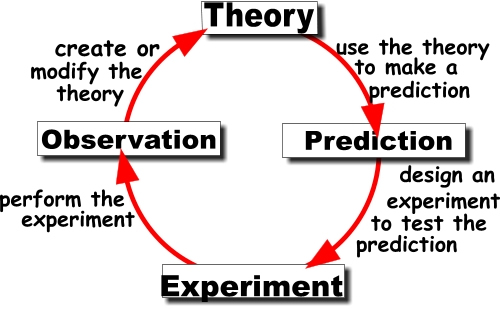9.1: The Scientific Process
- Page ID
- 172929
\( \newcommand{\vecs}[1]{\overset { \scriptstyle \rightharpoonup} {\mathbf{#1}} } \)
\( \newcommand{\vecd}[1]{\overset{-\!-\!\rightharpoonup}{\vphantom{a}\smash {#1}}} \)
\( \newcommand{\dsum}{\displaystyle\sum\limits} \)
\( \newcommand{\dint}{\displaystyle\int\limits} \)
\( \newcommand{\dlim}{\displaystyle\lim\limits} \)
\( \newcommand{\id}{\mathrm{id}}\) \( \newcommand{\Span}{\mathrm{span}}\)
( \newcommand{\kernel}{\mathrm{null}\,}\) \( \newcommand{\range}{\mathrm{range}\,}\)
\( \newcommand{\RealPart}{\mathrm{Re}}\) \( \newcommand{\ImaginaryPart}{\mathrm{Im}}\)
\( \newcommand{\Argument}{\mathrm{Arg}}\) \( \newcommand{\norm}[1]{\| #1 \|}\)
\( \newcommand{\inner}[2]{\langle #1, #2 \rangle}\)
\( \newcommand{\Span}{\mathrm{span}}\)
\( \newcommand{\id}{\mathrm{id}}\)
\( \newcommand{\Span}{\mathrm{span}}\)
\( \newcommand{\kernel}{\mathrm{null}\,}\)
\( \newcommand{\range}{\mathrm{range}\,}\)
\( \newcommand{\RealPart}{\mathrm{Re}}\)
\( \newcommand{\ImaginaryPart}{\mathrm{Im}}\)
\( \newcommand{\Argument}{\mathrm{Arg}}\)
\( \newcommand{\norm}[1]{\| #1 \|}\)
\( \newcommand{\inner}[2]{\langle #1, #2 \rangle}\)
\( \newcommand{\Span}{\mathrm{span}}\) \( \newcommand{\AA}{\unicode[.8,0]{x212B}}\)
\( \newcommand{\vectorA}[1]{\vec{#1}} % arrow\)
\( \newcommand{\vectorAt}[1]{\vec{\text{#1}}} % arrow\)
\( \newcommand{\vectorB}[1]{\overset { \scriptstyle \rightharpoonup} {\mathbf{#1}} } \)
\( \newcommand{\vectorC}[1]{\textbf{#1}} \)
\( \newcommand{\vectorD}[1]{\overrightarrow{#1}} \)
\( \newcommand{\vectorDt}[1]{\overrightarrow{\text{#1}}} \)
\( \newcommand{\vectE}[1]{\overset{-\!-\!\rightharpoonup}{\vphantom{a}\smash{\mathbf {#1}}}} \)
\( \newcommand{\vecs}[1]{\overset { \scriptstyle \rightharpoonup} {\mathbf{#1}} } \)
\( \newcommand{\vecd}[1]{\overset{-\!-\!\rightharpoonup}{\vphantom{a}\smash {#1}}} \)
\(\newcommand{\avec}{\mathbf a}\) \(\newcommand{\bvec}{\mathbf b}\) \(\newcommand{\cvec}{\mathbf c}\) \(\newcommand{\dvec}{\mathbf d}\) \(\newcommand{\dtil}{\widetilde{\mathbf d}}\) \(\newcommand{\evec}{\mathbf e}\) \(\newcommand{\fvec}{\mathbf f}\) \(\newcommand{\nvec}{\mathbf n}\) \(\newcommand{\pvec}{\mathbf p}\) \(\newcommand{\qvec}{\mathbf q}\) \(\newcommand{\svec}{\mathbf s}\) \(\newcommand{\tvec}{\mathbf t}\) \(\newcommand{\uvec}{\mathbf u}\) \(\newcommand{\vvec}{\mathbf v}\) \(\newcommand{\wvec}{\mathbf w}\) \(\newcommand{\xvec}{\mathbf x}\) \(\newcommand{\yvec}{\mathbf y}\) \(\newcommand{\zvec}{\mathbf z}\) \(\newcommand{\rvec}{\mathbf r}\) \(\newcommand{\mvec}{\mathbf m}\) \(\newcommand{\zerovec}{\mathbf 0}\) \(\newcommand{\onevec}{\mathbf 1}\) \(\newcommand{\real}{\mathbb R}\) \(\newcommand{\twovec}[2]{\left[\begin{array}{r}#1 \\ #2 \end{array}\right]}\) \(\newcommand{\ctwovec}[2]{\left[\begin{array}{c}#1 \\ #2 \end{array}\right]}\) \(\newcommand{\threevec}[3]{\left[\begin{array}{r}#1 \\ #2 \\ #3 \end{array}\right]}\) \(\newcommand{\cthreevec}[3]{\left[\begin{array}{c}#1 \\ #2 \\ #3 \end{array}\right]}\) \(\newcommand{\fourvec}[4]{\left[\begin{array}{r}#1 \\ #2 \\ #3 \\ #4 \end{array}\right]}\) \(\newcommand{\cfourvec}[4]{\left[\begin{array}{c}#1 \\ #2 \\ #3 \\ #4 \end{array}\right]}\) \(\newcommand{\fivevec}[5]{\left[\begin{array}{r}#1 \\ #2 \\ #3 \\ #4 \\ #5 \\ \end{array}\right]}\) \(\newcommand{\cfivevec}[5]{\left[\begin{array}{c}#1 \\ #2 \\ #3 \\ #4 \\ #5 \\ \end{array}\right]}\) \(\newcommand{\mattwo}[4]{\left[\begin{array}{rr}#1 \amp #2 \\ #3 \amp #4 \\ \end{array}\right]}\) \(\newcommand{\laspan}[1]{\text{Span}\{#1\}}\) \(\newcommand{\bcal}{\cal B}\) \(\newcommand{\ccal}{\cal C}\) \(\newcommand{\scal}{\cal S}\) \(\newcommand{\wcal}{\cal W}\) \(\newcommand{\ecal}{\cal E}\) \(\newcommand{\coords}[2]{\left\{#1\right\}_{#2}}\) \(\newcommand{\gray}[1]{\color{gray}{#1}}\) \(\newcommand{\lgray}[1]{\color{lightgray}{#1}}\) \(\newcommand{\rank}{\operatorname{rank}}\) \(\newcommand{\row}{\text{Row}}\) \(\newcommand{\col}{\text{Col}}\) \(\renewcommand{\row}{\text{Row}}\) \(\newcommand{\nul}{\text{Nul}}\) \(\newcommand{\var}{\text{Var}}\) \(\newcommand{\corr}{\text{corr}}\) \(\newcommand{\len}[1]{\left|#1\right|}\) \(\newcommand{\bbar}{\overline{\bvec}}\) \(\newcommand{\bhat}{\widehat{\bvec}}\) \(\newcommand{\bperp}{\bvec^\perp}\) \(\newcommand{\xhat}{\widehat{\xvec}}\) \(\newcommand{\vhat}{\widehat{\vvec}}\) \(\newcommand{\uhat}{\widehat{\uvec}}\) \(\newcommand{\what}{\widehat{\wvec}}\) \(\newcommand{\Sighat}{\widehat{\Sigma}}\) \(\newcommand{\lt}{<}\) \(\newcommand{\gt}{>}\) \(\newcommand{\amp}{&}\) \(\definecolor{fillinmathshade}{gray}{0.9}\)The Scientific Revolution grew out of Renaissance humanism. By the late 16th century, humanistic scholars were increasingly dissatisfied with some ancient authors, who failed to explain everything. For example, while ancient authors wrote about astronomy, they did not adequately explain the observed movements of the stars and planets. Likewise, with the explosion of new translations of classical works, it became clear that ancient scholars had actively debated and even rejected the teachings of figures like Aristotle.
Even to scholars who respected and deferred to ancient authors, much of ancient astronomy was based on some fairly questionable speculations, like the idea that the Earth sits on top of a giant sea that occasionally sloshes around, causing earthquakes. Thus, the first major discoveries in the Scientific Revolution had to do with astronomy, as scholars started carrying out their own observations and advancing theories to explain what they saw happening in the heavens. This process is known as inductive reasoning: starting with disparate facts, then working toward a theory to explain them.
Deductive reasoning starts with a known theory and then tries to prove that observations fit into it. This system allows for proofs. For instance, in mathematics, one can start with a known principle and then use it to prove more complex formulas.
Mathematics played a key role in the Scientific Revolution. Many thinkers insisted that mathematics was part of a divine language that existed apart from, but was as nearly important as, the Christian Bible itself. God had designed the universe in such a way that mathematics offered the possibility of real scientific certainty. The close relationship between math, physics, and engineering is obvious in the work of people like Da Vinci, Galileo, and Isaac Newton, all of whom combined an advanced understanding and practical applications of math.
A word of caution: It would be wrong to claim that the Scientific Revolution sparked a completely objective, recognizably “modern” form of science. Isaac Newton was a scientist, but also an alchemist, devoting considerable time and effort to trying to figure out how to “transmute” base metals like lead into gold. Likewise, many thinkers were intensely interested in the works of an ancient (and fictional) philosopher and magician named Hermes Trismagistus, Hermes the “Thrice-Blessed,” who had supposedly discovered a series of magical formulas that explained the universe. Crossover between what we might think of as magic and spirituality on the one hand and “real” science on the other occurred. Ultimately, the interest in discovery was piqued by the idea of probing the universe’s secrets leading to genuine scientific discovery.
Codifying and popularizing the new empirical, inductive process was led by Francis Bacon (1561 – 1626), an English nobleman. Bacon is best remembered for “creating” the scientific method: advancing a hypothesis to explain observed data, but then trying to disprove the hypothesis rather than trying to force the facts to prove it. Over time, the scientific method came to include a corollary requirement: the results of an experiment had to yield the same results consistently in order for a hypothesis to be considered viable.
It's interesting to note that Bacon was not a scientist himself. He was fired as the Lord Chancellor of King James I after accepting bribes. Then, he died after catching a cold stuffing snow into a dead chicken as some kind of ill-conceived biological experiment. Regardless, he codified the new methodology and worldview of the Scientific Revolution itself.
Simplified Scientific Method
The scientific method uses observation and experimentation to explain theories on the workings of the universe. This process removed blind adherence to tradition from science and allowed scientists to logically find answers through the use of reason. Over time, the method would be expanded to include more steps and accommodate different areas of study.

Source: LearnSocialStudies.org

